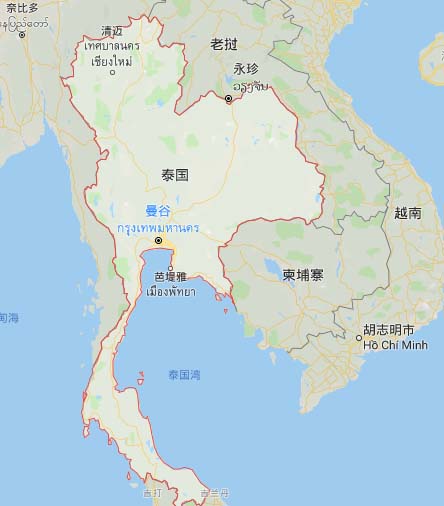- Current Location:
- Home>
- Investing/ASEAN>
- Thailand
Introduction to Thailand
[name]The Kingdom of Thailand.  [area] 513000 square kilometers.
[area] 513000 square kilometers.
[population] 69 million. There are more than 30 nationalities in the country. The Thai nationality is the main ethnic group, accounting for 40% of the total population, while the rest are Lao, Chinese, Malay, Khmer, as well as Miao, Yao, Gui, Wen, Kron, Shan, Samang, Shagai and other mountain nationalities. Thai is the national language. More than 90 per cent of the population believes in Buddhism, Malays believe in Islam, and a small number of people believe in Christianity, Catholicism, Hinduism and Sikhism.
Bangkok (Bangkok), population is 8 million.
[head of State] King Vajiralongkorn (MAHA VAJIRALONGKORN BODINDRADEBAYAVARANGKUN), Rama X. Ascended the throne in October 2016.
[important Festival] Song Gan Festival (April 13-15 of the Gregorian calendar); Water Lantern Festival (December 15 of the Thai calendar); National Day (December 5 of the Gregorian calendar).
It is located in the south-central part of the Indo-China Peninsula. Bordered by Cambodia, Laos, Myanmar and Malaysia, southeast by the Gulf of Thailand (Pacific Ocean), southwest by the Andaman Sea (Indian Ocean), a tropical monsoon climate, the year is divided into hot, rain and cool three seasons, the average annual temperature of 27 ℃.
In 1238 AD formed a more unified country, has experienced the Sukhtai Dynasty, the Great City Dynasty, the Tonburi Dynasty and the Bangkok Dynasty, formerly known as Siam. In the 16th century, colonists such as Portugal, the Netherlands, Britain and France invaded one after another. In 1896, Britain and France signed a treaty stipulating Siam as a buffer state between British Myanmar and French Indochina. Siam became the only country in Southeast Asia that had not been colonized. At the end of the 19th century, King Rama IV began to open to the outside world, and King V learned from the experience of the West to carry out social reform. In June 1932, the Democratic Party launched a coup and changed the autocratic monarchy to a constitutional monarchy. It was renamed Thailand in 1939 and was officially named Thailand in 1949 after several changes.
To exercise a constitutional monarchy. After World War II, the junta held power for a long time, and the government changed frequently for a time. Since the 1990s, soldiers have gradually faded out of politics. In 2001, the Thai Rak Thai Party won the national election. Thaksin became prime minister and was re-elected in 2005. In September 2006, a military coup took place and Thaksin stepped down. In 2007, a national election was held, and the people's Power Party won and Sharma, the head of the party, became prime minister. In September 2008, Sharma was convicted of unconstitutional ouster, and the people's Power Party elected Somchai to take over as prime minister. In December, the Constitutional Court convicted the people's Power Party, the Thai Party and the Democratic Party of the mean of bribing elections, disbanded them, and Somchai stepped down. On December 15, the head of the Democratic Party, Abhisit, was elected prime minister. In May 2011, Abhisit announced the dissolution of the House of Commons and held national elections in July, winning more than half of the seats in the House of Commons for Pheu Thai. In August, the Yingluck government was established. In December 2013, Yingluck announced the dissolution of the House of Commons and re-election. In February 2014, elections for the House of Commons were held in Thailand, and voting in some areas could not be held smoothly due to opposition boycotts. In March, the Constitutional Court ruled that the general election was null and void. On 22 May, the military took over power in the name of the "National Stabilization Mission". On 31 July, the National Legislative Assembly was formed. On August 21, the Legislative Assembly elected Prayuth, chairman of the "National Stabilization Mission" and commander of the army, as the new prime minister. On the 24th, Prayuth became prime minister. In August 2015, December 2016 and November 2017, Prayuth adjusted his Cabinet three times. On October 13, 2016, King Bhumibol Adulyadej of Thailand died and King Vajiralongkorn ascended the throne.
[constitutional Law] the current Constitution, the 20th Constitution of Thailand, entered into force on 6 April 2017 with the approval of King Vajiralongkorn.
The National Legislative Assembly is responsible for the enactment of laws and the exercise of the functions and powers of Congress and the upper and lower houses. Established in July 2014, with a total of 250 members. The current President of the Legislative Assembly Pompey, Vice-chairmen Surachai, Pelassa.
[government] in November 2017, the Pakistani government reshuffled its cabinet. Members of the current cabinet include Prime Minister General Prayuzhan Ochan (GEN.PRAYUT CHAN-O-CHA), Deputy Prime Minister and Minister of Defense General Bawion Suwan (Deputy Prime Minister and Minister of Justice Ba Jin Zhendong Air Force General (ACM.PRAJIN JUNTONG),) Deputy Prime Minister MR.SOMKID JATUSRIPITAK), Vice Prime Minister MR.WISSANU KREA- NGAM), Deputy Prime Minister Gen. GEN.CHATCHAI SARIKALYA and other five deputy prime ministers as well as foreign affairs, commerce, transportation and other ministers, a total of 36 people.
[administrative divisions] the country is divided into five regions: central, southern, eastern, northern and northeastern, with a total of 77 prefectures, with counties, districts and villages. Bangkok is the only municipality directly under the central government. Yin is a civil servant appointed by the Ministry of the Interior. The mayor of Bangkok is directly elected.
NEXT:无
NEXT:无
- Why Choose Singapore
- 10 Advantages of Singapore formation
- Tax Exemptions for Singapore Statrups
- Why Choose ERI
- We are Chartered Accountant
- We are Chartered Secretary
- 20 years'experience,served 8000+clients
- Strategic Partners
- Singapore UOB
- Singapore OCBC
- Newsletter Subscription
- Government,Business,Funding,Listing,Finance
- Weekly updates,welcome to subscribe FOC
- Partne with us
- Opportunities for mutual prosperity

 0065-62250588
0065-62250588







